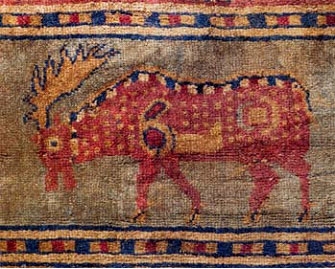History of Carpets and Kilims
 Carpet, despite being a daily furniture of Turkish people used for sitting or praying has been raised to level of a “work of art”, a type of expression of our culture.
Carpet, despite being a daily furniture of Turkish people used for sitting or praying has been raised to level of a “work of art”, a type of expression of our culture.
In Siberia, a region where Turkish people used to live, at the feet of Altay Mountains and at the fifth of Pazırık kurgans, the oldest carpet found under glaciers eas woven using Turkish knot. It is generally accepted idea that this carpet is appropriated for the Asian Khuns and for 3rd-2nd centuries BC.Furthermore, a connection with the Khun Turks has been pointed out by Turkologue Osman Nedim Tuna who read Turkish words written in Gokturk alphabet on wood of harness that had found in the kurgan.
45 years before Rudenko explored the Pazırık carpet, in 1906-1908, Aurel Stein had found knotted carpet, in 1906-1908, Aurel Stein had found knotted carpet pieces dated 3rd-4th centuries in Lou-Lan in Eastern Turkistan. In 1913, during his Turfan researches, A. Von Le Cog found another knotted carpet piece in Kızıl, in west Kuça, which dates back to 5th-6th centuries.

In Abbasi period, Turkish people brought the art of carpet-weaving to the world of Islam. One of the two carpet pieces with kufi inscription found in old Cairo(Fustat), in Cairo Arabic Museum, dates back to 817-8(202 in Muslim Calendar). The third piece with kufi inscription puplished by Lamm alongwith other samples in Sweden collection is in Washington Textile Museum. Those carpets are considered as samples from Abbasid period. The resemblance they have shown with those in Eastern Turkistan in terms of knotting technique may point out to their Turkish origin.
The most important characteristic of Turkish art of carpet weaving is its continuity. It is important not to disregard the tradition while developing a new source or receiving any motifs or elements.
However, it is important also to note that freedom of expression is the basis of innovation in art.
Kaynak:Ariş dergisi Aralık 1997 Prof.Dr.Oktay Aslanapa

 0
0
 0
0